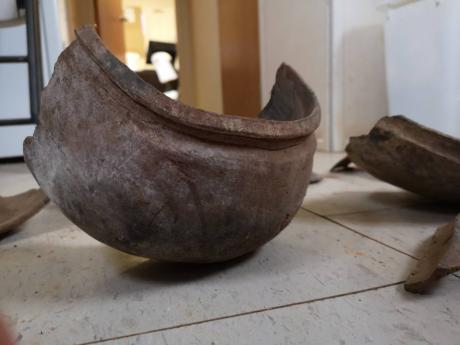TAINO FIND - Israeli miner turns over artefacts, remains found in Hellshire to Heritage Trust
As Jamaica celebrates 57 years of Independence from Britain, a recent discovery of centuries-old artefacts and remains serves as a timely reminder of another important part of the nation’s journey. The find harks back to the pre-colonial days when the land of wood and water, Xaymaca, was the stomping ground of the island’s earliest settlers, the Tainos.
A quarry blast scheduled for May 28 in the hills of Hellshire in St Catherine led to the discovery of artefacts believed to be at least 500 years old.
Contracted by Gore Developments as manager for the quarry, which was opened last year, miner Tal Giller from the city of Sderot in Israel uncovered the items while extracting sand, limestone, gravel and stone to produce construction aggregate.
“On that day, we actually were waiting. We already loaded the explosives inside the mountain and we were ready to blast it, then one of the operators of the excavator said to me that he found a cave,” Giller explained.
The miner was concerned that the cave would collapse after the blast to break the rocks for excavation, so he delayed the operator, and after checking that it was safe enough to enter, he ventured inside where the artefacts were discovered.
“We found some bones inside of it and also some things that looked like plates and bowls,” Giller told The Gleaner.
After removing the artefacts, they set off the blast and, fortunately, the cave did not collapse.
Giller kept the finds at his office until archaeologists from the Jamaica National Heritage Trust (JNHT), whom he had contacted, arrived for a site visit.
Selvenious Walters, JNHT technical director of archaeology, explained that the artefacts were found in a rock shelter, which is a shallow, cave-like opening in a cliff.
“It’s actually a burial site because among the artefacts there were human remains – skeletal remains, but not complete skeletal remains, just body parts,” Walters told The Gleaner.
A portion of the shelter was excavated and it confirmed that a secondary burial had taken place, meaning that the body was buried elsewhere before being reburied in the rock shelter.
“The remains were buried with a Zemi made from clay – a complete Zemi. It’s about four inches in height and that was also found with some pottery,” said Walters, who said this provides concrete evidence that the remains date back to the Tainos.
The Zemi was a central figure in their religion and houses the spirit of the Taino.
Walters explained that the fragments of pottery formed part of a ceremonial bowl as the Taino would bury their dead with a bowl of food to accompany them on their journey into the afterlife, whether it was a complete or secondary burial.
The 15 bones and fragments of pottery recovered by Giller and the archaeologist have been curated by the JNHT.
“It becomes part of our collection and serves as research material for the area,” said Walters.
It is the desire of the JNHT to map a comprehensive pattern of the settlement distribution of the Tainos across the island. At present, the picture is sketchy. The majority of the sites already discovered and documented are along the coastal fringes away from the interior of the island, with the exception of Nanny Town.
Giller said he was not totally surprised by the JNHT’s confirmation of what the artefacts were, as he had done research before coming to Jamaica and learnt about the island’s early settlers.
“When I found it, I just knew that was what I found ... . What was important to me was to make sure that it’s not going to get damaged because this is the history of this island,” Giller said.



